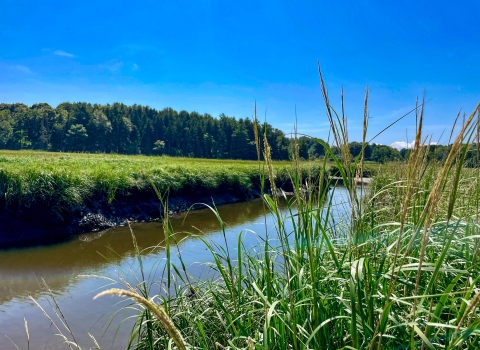Prescribed burning, conducted under an approved plan with the use of adequate firefighting resources, is the best method to prevent potential loss from a wildfire. Firefighters from the U.S. Fish and Wildlife Service, U.S. Forest Service, and the National Park Service will be assisting local Refuge Fire Management personnel with the prescribed fires.
Historically, natural fires occurred every five to ten years but fire suppression efforts, along with development and grazing, have altered the natural fire cycle. Mesquite trees have flourished with the absence of fire and these trees continue to dominate Refuge vegetation, choking out the once open semidesert grassland.
Prescribed burning reduces the total amount of vegetation and stimulates growth of native species that are adapted to naturally occurring fires. Refuge biologists and fire personnel worked together to develop a plan that will benefit wildlife and promote the habitat needs of endangered species such as the Masked Bobwhite Quail. Prescribed burning treatments, while expensive, may cost as little as one tenth that of a large scale, wildfire suppression effort. All burn plans are developed using national interagency standards developed by qualified and experienced fire management professionals. The plans are extensively reviewed and must be approved by the Refuge Manager prior to ignition.
Fire Management personnel on the Buenos Aires NWR will closely monitor weather and fuel conditions to maximize results and minimize smoke impacts on adjacent communities. Burns will only be conducted during the daytime hours. Highway 286 and the Arivaca-Sasabe road may be heavily impacted by smoke for short periods of time. Smoke may also be visible to residents in Arivaca, Sasabe, Three Points, Green Valley, Nogales and Tucson in southern Arizona.
The U.S. Fish and Wildlife Service is the principal Federal agency responsible for conserving, protecting and enhancing fish, wildlife and plants and their habitats for the continuing benefit of the American people. The Service manages the 95-million-acre National Wildlife Refuge System, which encompasses 547 national wildlife refuges, thousands of small wetlands and other special management areas. It also operates 69 national fish hatcheries, 64 fishery resources offices and 81 ecological services field stations. The agency enforces federal wildlife laws, administers the Endangered Species Act, manages migratory bird populations, restores nationally significant fisheries, conserves and restores wildlife habitat such as wetlands, and helps foreign and Native American tribal governments with their conservation efforts. It also oversees the Federal Assistance program, which distributes hundreds of millions of dollars in excise taxes on fishing and hunting equipment to state fish and wildlife agencies.
Visit the Service's website at http://www.fws.gov
NOTE: For local fire restrictions and fire information for Federal, Tribal and State lands in Arizona and New Mexico:
- Check our website www.fs.fed.us/r3/fire
- Phone 1-877-864-6985 (toll free).


